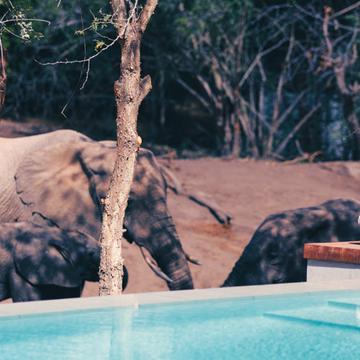10 Kid-Friendly Destinations for Spotting Wildlife
By , on




The thrill of wildlife-watching not only enriches a child’s knowledge of the natural world but is also a golden opportunity for family bonding. From the meditative calm of silently waiting to spot an elusive lioness among the bush in Kruger Park to the euphoric delight of seeing a humpback whale crest the waters of the Norwegian Sea, wildlife holidays make for the perfect family adventure. Continue reading for a round-up of our favourite family-friendly destinations for spotting wildlife:
1. South Africa: For the Big Five
South Africa is a real El Dorado for families in search of mega-fauna in their natural habitat. With a level of comfort second to none for families looking to explore Africa, the dream of seeing lions, leopards, elephants, buffaloes and rhinos can really come true for you and your family.
Imagine walking along the dusty bush tracks of Kruger park with your kids hanging on to their binoculars, excited to share everything they find with you. At night, as you slowly drift off to sleep, hear the sounds of the animals of the bush coming to life. Family safaris in South Africa are undoubtedly the ultimate travel experience for kids.




When?
Year-round; the best time to visit being between April and October.
Minimum age:
There are no restrictions in the national parks but preferably from 5 years and upwards.
Animals to spot:
The big ones to watch out for are lions, rhinos, hippos, elephants, giraffes and monkeys.
2. Sri Lanka: For Asian elephants
If you can't make it to Africa, start off with a Sri Lankan safari with your children. Many parks such as Minneriya and Uda Walawe are well-organised and accessible to children while not being too expensive. It is in these tropical landscapes that your children can spot one of the greatest icons of the jungle: the Asian elephant.
Safaris here start early in the morning but don’t worry, sleepy sulks will soon be replaced by wide-eyed wonder. In no time at all, you’ll find yourself nose to nose (or rather, nose to trunk) with herds of wild elephants.




When?
Throughout the year, the best time to visit being between November and April.
Minimum age:
There are no restrictions but preferably 5 years and older.
Animals to spot:
Apart from the elephants, Sri Lanka has a high concentration of leopards, sloth bears, and many fascinating endemic species like the red slender loris, purple-faced langur, two species of chevrotains, and a multitude of birdlife.
3. Madagascar: For otherworldly creatures and habitats
This magnificent island nation contains whole worlds within itself. It's no coincidence that it was chosen as the setting for the DreamWorks film with the same name. On the eastern coast, Kirindy Forest Reserve comes to life in the nighttime: the giant jumping rat scurries about industriously while nocturnal dwarf and mouse lemurs leap between the trees. Travel to the west coast and suddenly you find yourself amidst lush jungles teeming with exotic creatures.
There is the Brookesia chameleon, the world’s smallest, and the Fossa — a mongoose-like creature that is the only mammalian land predator of the island. Underfoot, you’ll see insects unlike anything you’d spot in the backyard; crimson red giraffe weevils scuffle for space with pink-hued caterpillars and lynx spiders.




When?
Visit between April and June or September and November for milder weather.
Minimum age:
Part of the Madagascar experience is rudimentary road networks and journeys that take longer than intended; this might be an adventure better enjoyed with older children and teenagers.
Animals to spot:
Apart from the hundred different species of lemurs, look out for the aptly-named tomato frog, the fierce fossa, the panther chameleon, different kinds of tenrecs, and a variety of different whales and dolphins in the surrounding waters.
4. The Galapagos: to witness evolutionary miracles
Like Madagascar, the Galapagos islands represent the curious case of evolution in isolation. The most interesting consequence is, in an environment devoid of apex predators, the surreal creatures that inhabit these islands show little fear of human presence.
This means you can walk beside blue-footed boobies and Galapagos penguins or swim in the sea alongside playful sea lions and placid schools of hammerhead sharks. If you’re feeling brave, you can creep closer to take a look at the primordial-looking saltwater iguana or sun yourself on the beach alongside golden-scaled land iguanas.




When?
You can visit the islands all year round; the wet season brings warmer temperatures and is ideal for observing marine life, while the dry season brings out a greater variety of wildlife.
Minimum age:
8 years and older; while the islands are quite navigable, children need to be old enough to keep up with long walks and respect the strict rules regarding interaction with the environment.
Animals to spot:
Be sure to spot the iconic Galapagos Tortoise. Other unique residents of the islands include Darwin’s finches (whose study helped formalise the theory of evolution), playful sea lions and fur seals, the endangered Galapagos green turtle and the flightless cormorant.
5. Finland: For fairytale woodlands
The densely wooded winter forests of Northern Finland are straight out of a Slavic fairytale. Hulking brown bears and magnificent wolves reign over this isolated realm that feels like the end of the world. Observe these creatures and others from up close by staying in a specially-designed hide, deep within the forests of pine and spruce.
Take your time in enjoying the perpetual wintry splendour of this part of the world and wander down wooded paths flanked with berry-bearing bushes (bilberries, cloudberries, lingonberries and more). On a family trip in Finland, children are taught how to identify common forest mushrooms as a civic skill in school — this holiday could be a great opportunity to teach your kids some wilderness skills as well.




When?
Finland boasts fascinating wildlife encounters all-year-round. Spring-time brings the bears whereas the lynxes and wolves are most active during the winter.
Minimum age:
Preferably from 5 years and upwards.
Animals to spot:
Be sure to look for the rarest seal species in the world, the Saimaa ringed seal, the elusive Eurasian brown bear and grey wolf, cuddly-looking ermines and wolverines, and the majestic white-tailed eagle.
6. India: Home to the Asiatic Lion
India contains several different eco-zones, including dry desert area, coniferous mountains, and tropical jungles. The country’s indigenous wildlife is similarly diverse, with around 8% of all mammalian species being indigenous to India. The main attractions are, of course, the royal Bengal tiger, which can only be found in India and Bangladesh, and the majestic Asiatic lion, nearly extinct and now only found in the grasslands of India.
In eastern India, you can find one-horned rhinoceroses, whose populations have only recently been revived from extinction. Along the western coast, the tropical forests of the Western Ghats are one of the most biodiverse spots on the planet, home to tigers, elephants, civet cats, and a host of colourful bird species endemic to the area.




When?
The winter months, between November and March, are a pleasant time to visit India.
Minimum age:
Preferably from 5 years and upwards.
Animals to spot:
The big attractions are the Bengal tiger, the Asiatic lion, and the Indian rhinoceros. Other fascinating species of the subcontinent include the Asian elephant, several species of leopards, the nilgai, and the gaur.
7. Belize: Gateway to Central American wildlife
Pocket-sized Belize is the perfect introduction to the astounding flora and fauna of Central America. Here, wildlife sanctuaries and parks are accessible to young families and travelling around the country is quick and easy. If your children are too young for long treks through national parks, Belize has many great conservation centres you can opt for instead.
In fact, a short trip from Belize City is Belize Zoo — its name belies the fact that it’s actually a sanctuary and rehabilitation centre. It's home to many well-loved endemic animals that have been rescued from captivity, orphanhood or injury. It’s here that you can see some of the more elusive species like the tapir (Belize’s national animal), the ocelot, and the jaguar.




When?
During the dry season, between November and April.
Minimum age:
Suitable for children of any age.
Animals to spot:
Among the many unusual residents of Belize, the ones to look out for are the nation’s national animal, the tapir, the howler monkey, the nocturnal gibnut, ocelot, kinkajou, and margay, the adorable coatimundi, and the jaguar.
8. Costa Rica: A birdwatcher’s paradise
Costa Rica’s richly biodiverse rainforests are bound to provide the adventure of a lifetime for young wildlife enthusiasts. For an introduction to the country’s unique wildlife, start by touring Manuel Antonio National Park. With the aid of a knowledgeable local guide, you’ll spot all the highlights: three-toed sloths and two-toed sloths, three different species of monkeys, iguanas, basilisks, dolphins in the nearby waters, and a mind-boggling variety of birds.
For an upgraded adventure, make your way to the cloud forest reserve of Monteverde, home to the world’s largest collection of wild orchids, ninety-one species of birds, and fifty-eight species of amphibians. If your trip allows you the time, spend time in Corcovado National Park, one of the most biodiverse spots on the planet, and Tortuguero National Park, isolated and comprising of rainforest, swamps, mangroves, lagoons and more — a favourite for families.




When?
During the dry season, between December and April.
Minimum age:
Preferably from 5 years and older.
Animals to spot:
Costa Rica has an incredibly diverse bird population. The scarlet macaws are iconic, but also look out for the resplendent quetzal, the mangrove hummingbird, the coppery-headed emerald, and the white-collared manakin. The country is known for its brilliantly coloured amphibians, including the red-eyed tree frog and the glass frog. The surrounding waters are home to many species of whales and dolphins, including the blue whale, the humpback whale, and the killer whale.
9. Australia: For strange and wonderful creatures
Australia is an outsized land with jumbo-sized fauna to match. The vast majority of wildlife here is endemic to the continent, owing to its geographic isolation. You’ll have to accept at the outset that you won’t be able to see it all; unless you’re planning on an indefinite family holiday in Oz. The good news is, the variety of wildlife here is so vast, you can’t possibly miss it wherever you include on your itinerary.
Even if you’re just touring the big cities, national parks like the Blue Mountains or the Grampians are an easy half-day drive out from urban centres. For the heavy-hitter mammals like dingoes, kangaroos, koalas, wallabies, wombats, and platypuses, you can see them in protected areas in New South Wales and Queensland.




When?
Australia has great wildlife watching opportunities all-year-round.
Minimum age:
Suitable for children of any age.
Animals to spot:
Australia is known for its diversity of marsupials, including kangaroos, koalas, wallabies, and wombats, and monotremes like the echidna and the platypus. The continent is also home to an incredible diversity of bird species, notably cassowaries, emus, cockatiels, and the Australian king parrot.
10. Norway: For Arctic wildlife
The boreal forests of Norway are some of the last places on the planet to still house all the traditional forest creatures you might have read about, growing up. The woods come alive with hedgehogs, shrews, rabbits, hares, beavers, badgers, deer, squirrels, lynxes, foxes, wolves, and all manner of other delightful creatures. In the icy arctic archipelago of Svalbard far north, the polar bear reigns supreme but shares its realm with the adorable-looking arctic fox and the regal Svalbard reindeer.
The coastal waters of the North Atlantic thrive with life; you can spot many species of whales, including humpback, bottlenose, sperm, minke, and blue whales. On some of the coastal fjords, you might even glimpse a herd of walruses sunning themselves.




When?
Norway has great wildlife watching opportunities all-year-round.
Minimum age:
Suitable for children of any age.
Animals to spot:
The animals that represent Norway are definitely the polar bear, the arctic fox, the Svalbard reindeer, the brown bear, the Eurasian wolf, and the Eurasian lynx. The coasts of Norway provide breeding grounds for seals and walruses in the spring season.
Looking for more inspiration?
Still haven't found what you're looking for? Head to our dedicated Family Travel Page to browse the best child-friendly destinations, tours, and experiences curated by our carefully-selected local agencies around the world.
Family travel inspiration






































